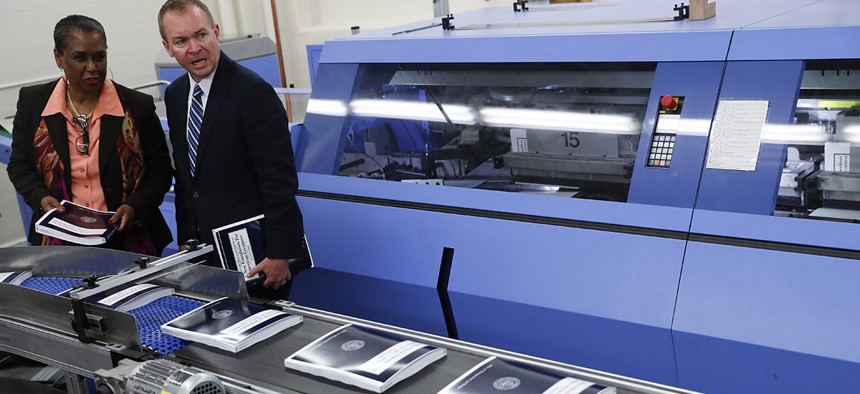For Trump’s Budget to Work, the US Will Need the Biggest Technology Boom Since World War II

White House budget director Mick Mulvaney, right, joined by GPO Director Davita Vance-Cooks, inspects the production run of President Donald Trump's fiscal 2018 federal budget, May 19, 2017. Carolyn Kaster/AP
In order to deliver both massive tax cuts and end U.S. borrowing within the decade, Trump’s budget forecasts the U.S. economy will grow at a real rate of more than 3 percent
One of the most revealing things in President Donald Trump’s budget proposal, due out today, is its extravagant assumptions about economic growth. Even a budget few expect to be enacted needed a behind-the-scenes boost to deliver plausible results, as it effectively assumes a technological revolution bigger than any since World War II.
In order to deliver both massive tax cuts and end U.S. borrowing within the decade, Trump’s budget forecasts the U.S. economy will grow at a real rate of more than 3 percent. And if you question that assumption, administration officials suggest you’re simply being unpatriotic.
Nonpartisan, experienced forecasters like the Congressional Budget Office and the Federal Reserve are predicting real GDP growth rates below 2 percent in the next few years, in line with recent experience:
The benefit to the White House of promising faster growth is clear. Faster growth implies higher tax revenues to the government. A stronger economy also implies fewer people will need “economic stabilization” programs like food stamps, unemployment insurance and health care subsidies (setting aside for a moment Trump’s budget would already cut many of these services). A Center on Budget and Policy Priorities analysis says overestimating annual growth by more than one percentage point could understate the need for borrowing by more than $3 trillion over the decade.
For a policymaker, that’s $3 trillion in wiggle room to promise a big tax cut while still reducing borrowing. It’s not like this maneuver is new: Presidents use it all the time, but typically on a much smaller scale. Barack Obama’s budget office, for example, was criticized last year for predicting GDP growth 0.3 percentage points higher than CBO did. By contrast, Trump’s estimates are more than an entire percentage point higher.
So how does the administration justify its more optimistic projection?
It will argue that its policies will unshackle the American economy. Cutting government spending, some kind of infrastructure investment plan and a major tax cut would return to the U.S. to a rate of growth not seen since 2003-2005.
But while such programs may boost growth, the boost is not likely to be as big and sustainable as the Trump administration wants. A Tax Policy Center analysis of a Trump tax plan suggested those measures might provide a stimulus in the first year or two thanks to windfall profits, but it will quickly recede. Moreover, even those benefits depend on all those plans being enacted in a timely fashion, when in fact the Republican legislative agenda is stuck in the mud.
And there’s an even more fundamental problem.
Forecasters at the Federal Reserve and CBO aren’t just thinking about short-term stimulus, but about what makes sustained economic growth happen. Two key factors are involved. One is the working-age population, which is growing more slowly than before, as Americans of the baby-boom generation retire and immigration slows.
That means fewer people will need to produce more to generate more growth. The other factor, then, is productivity growth—how much an individual’s ability to produce is increasing.
Productivity growth is typically the result of technological advances that allow each worker to do more work. To enable a slow-growing labor force to generate 3 percent real economic growth, productivity would have to increase faster over the next decade than at any period recorded since World War II, according to the CBPP analysis, and at double the rate CBO is forecasting.
It’s not that this is impossible; maybe the internet is about to radically change our work lives. But it would be quite a surprise, given that over the past 10 years—when the internet really took off—U.S. productivity growth has been at its lowest since the 1970s. There’s no obvious reason to think it will suddenly jump again.
Yet, for the Trump team, such doubts are apparently a sign of a lack of patriotism.
“It is sad that the CBO and the last administration assumed we’ll never grow beyond 1.9 percent again,” White House budget director Mick Mulvaney told reporters yesterday. “That assumes a pessimism about America, its economy and its culture that we refuse to accept.”
Confidence in America can be contagious, but blind faith isn’t always catching. Though this budget stands little chance of being enacted as it stands—majorities in Congress oppose many of its cuts—it would need real serendipity to avoid wildly overshooting its estimated debt load and leaving the U.S. in an even bigger mess.
At least Mulvaney was speaking the truth when he said “we can never balance the budget at 1.9 percent, it’s not going to happen.” The problem? That’s his job.






